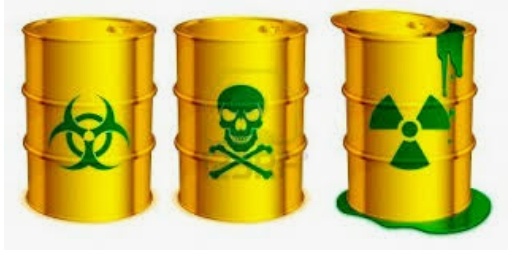
Chemical Hazards
The chemical risk is susceptible to risk since it is produced for a non-controled exposition to chemical agents. It can produce acute or chronic effects and the appearance of illnesses.
Toxic chemicals can also cause local and systematic consequence according to the nature of the product and the route of exposure.
In many countries the dangerous chemical products are literally thrown, often with serious cosequences for humans and the natural environment, causing a chemical risk.
Depending on the product, the cosequences can be serious Health problems for workers and the community and permanent damage to the natural environment. Nowadays, almost all workers are exposed to some type of chemical risk, because dangerous chemicals are used in almost all branches of industry.
Hazardous chemical products
The material form of a hazardous chemical product may influence in how it penetrates the body and, to some extent, the damage it causes. The main material forms are: solids, powders, liquids and gases.
Solids: are the forms that hazardous chemicals are likely to cause chemical poisoning, aithough some can cause poisoning, if they touch the skin. They can give off toxic vapors that can be inhaled and solids can be flammable and explosive as well as corrosive to the skin .
Dust: they are small particles of solids.The main danger of dust is that you can breathe it and it penetrates into the lungs having harmful effects to Health, causing, injury to the eyes and bloodstream, and it can also pass to other parts of the body.
Liquids: liquid chemicals are dangerous because they give off vapors that can be inhaled and are highly toxic. Some products can immediately damage the skin and others pass through the skin into the bloodstream . Their they can be moved to different parts of the body. Humidities and vapours are often invisible.
Vapors: many liquid chemicals evaporate at room temperature, which means they form a vapor and remain in the air, which can irritate the eyes, skin and their inhalation can have serious Health cosequences. Vapors can be flammable or explosive.
Gases: gases can have harmful Properties ( toxic, corrosive) or dangerous (flammable, explosive). The detection of their presence by odor is misleading, many gases and vapors have their toxicity threshold lowered by the threshold of odor.
Activities in which you are exposed to chemical risks
• Teaching and research activities in laboratorios.
• Welding tasks
• Degreasing operations
• Foundry operations
• Distillations, rectifications and extractions.
• Cleaning of chemical products.
Exposure to chemicals
Exposure to toxic chemicals can lead to higher rates of workplace accidents, for example: chemicals such as solvents and asphyxiants can slow a worker reactions by affecting his nervous system or reducing the amount of oxygen reaching his lungs. The slowness to react can be very serious (and even fatal) if the worker is in a dangerous situation that requieres an immediate response
Security measures in the labor area with decree 351/97
Installations and equipment must be protected against the corrosive effect of the substances used.
They must have acoustic alarm devices, visuals where infectious and, contaminating substances are handled.
I Mark and protect the affected área or element in case of corrosive substances spillage
Incompatible products must be separated
Identification of risk products Stored
Provide adequate personal protective equipment for personnel
Emergency showers and/or eye wash should be available in areas with hazardous products
Safety plan in case of emergency and places in a visible place








